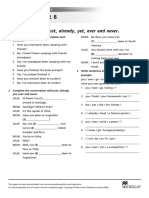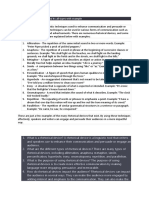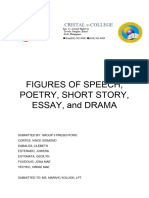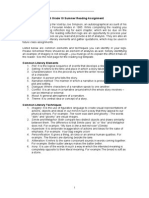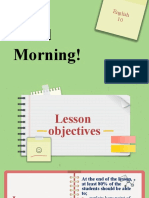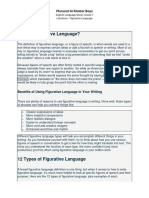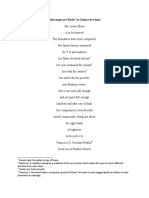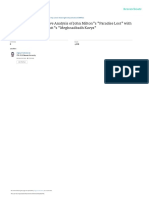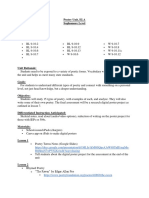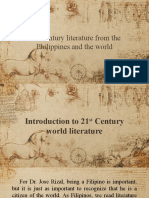0 ratings0% found this document useful (0 votes)
6 viewsFigures of Speech
Figures of Speech
Uploaded by
bakoymoralesCopyright:
© All Rights Reserved
Available Formats
Download as DOCX, PDF, TXT or read online from Scribd
Figures of Speech
Figures of Speech
Uploaded by
bakoymorales0 ratings0% found this document useful (0 votes)
6 views3 pagesCopyright
© © All Rights Reserved
Available Formats
DOCX, PDF, TXT or read online from Scribd
Share this document
Did you find this document useful?
Is this content inappropriate?
Copyright:
© All Rights Reserved
Available Formats
Download as DOCX, PDF, TXT or read online from Scribd
Download as docx, pdf, or txt
0 ratings0% found this document useful (0 votes)
6 views3 pagesFigures of Speech
Figures of Speech
Uploaded by
bakoymoralesCopyright:
© All Rights Reserved
Available Formats
Download as DOCX, PDF, TXT or read online from Scribd
Download as docx, pdf, or txt
You are on page 1of 3
1. Alliteration - the repetition of the initial consonant sound.
She sells seashells by the seashore.
In the example above, the /s/ sound is being repented in the succeeding initial consonantsound of the
word sells, seashells, and seashore. You might wonder why the word "she" is not included. This is
because it begins with a different consonant sound- /f/ or /sh/. It is important that when using this figure
of speech, you are familiar with the various symbols in the International Phonetic Alphabet (IPA), which
serves as an accurate guide in the pronunciation of sounds.
2. Assonance - the repetition of the internal vowel sounds.
How now brown cow?
The words in the example above have a repeating diphthong /au/ sound. When using assonance,
remember that it is not how the word is spelled, but how it is pronounced that matters. For example,
despite having the same '-own" letters, the words "blown" and "brown" are pronounced differently.
Note that diphthongs are blended vowel sounds.
3. Anaphora - repetition of same word or phrase in a successive clauses or sentences.
I live to overcome the mistakes of the past, the mistakes untold, and the mistakes unnoticed.
The phrase the mistakes is repeated in the sentence above.
Change me for what I have done. Change him for what he did. Change them, so we can live.
4. Apostrophe - addressing an inanimate object as if it is alive or someone who is not present.
Evry said, "what will I do without your genius brain, my computer!”
The computer is an inanimate object and was addressed like as if it was alive.
“Oh! Dr. Jose Rizal, will you please guide these perverted minds?"
Dr. Jose Rizal is no longer living, yet his ideology and impact on Filipinos live on that his name is still
sometimes referenced in people's remarks to add impact.
5. Personification - giving attribute of human to an inanimate object.
The mountain will bow to the touch of the strongest wind.
The mountain cannot bow in reality, and the wind has no hands to touch. However, in personification,
these inanimate objects are given human- like actions. It only differs from an apostrophe in terms of
usage.
6. Chiasmus - a verbal pattern in which the second half is balanced with the first but written in reversed.
Reading to learn is different from learning to read. Do you get it?
In the example you will see how the sense of the two phrases changed by just changing or reversing the
position of the words in the sentence. Changing the inflection of the word is also necessary to make the
sentence grammatically correct.
7. Euphemism - the use of an inoffensive word or phrases in substitution to an offensive word.
Her mother went to the other side after battling for a 10-year leukemia.
As you may have noticed, the phrase "went to the other side" is an alternative and even kinder term for
the word "died."
Hyperbole - an exaggerating the thought unit that should not be read in the literal sense.
I spent a billion pesos on shopping today.
Although it is possible to spend billions of pesos if you are extremely rich, this could still be interpreted
as hyperbole in the sense that spending that much money on regular shopping would be considered
excessive.
8. Metaphor - a figure of speech that makes an implicit comparison of a word or phrase to another to
show similarity.
Her smile is a sunshine during summertime.
In the example above, "smile" is compared to "sunshine". Notice that the linking verb "is" is used here to
compare the two.
9. Simile - just like metaphor, this figure of speech compares two different objects or persons with a
similar characteristic and use; "like" and "as".
You were as brave as a lion.
Notice the signal word "as" in the sentence in comparing the bravery of the person to a lion.
10. Onomatopoeia - the used of words that imitate the sounds associated with the objects or actions they
refer to.
The boxes fell from the shelves with a very loud thump.
The example above stimulates your senses that you can imagine how loud the books fell because of the
use of the word thump.
11. Synecdoche - the use of a part to represent the whole.
Two heads are better than one in accomplishing a task.
The word "heads" represents people helping each other in making a task easier.
The different figures of speech that you have learned from this lesson are examples of things that have
been taught to you or that you have already encountered in your previous years of studying Literature.
Below are some additional literary devices that are also helpful in reading and appreciating both prose
and poetry. These can be found at masterclass.com.
1. Allegory - is a literary device used to express large, complex ideas in an approachable manner.
Allegory allows writers to create some distance between themselves and the issues they are
discussing, especially when those issues are strong critiques of political or societal realities.
A good example of an Allegory is found in the 5th chapter book of Jacob from the Book of Mormon. It
tells the story of the olive trees from a vineyard that when analyzed, talks about God's plan and salvation.
2. Allusion - a popular literary device used to develop character, frame storylines, and help create
associations with well-known works. Allusions can reference anything from Victorian fairy tale and
popular culture to the Bible and the Bard.
3. Anachronism – Imagine reading a story about a caveman who microwaves his dinner or watching
a film adaptation of a Jane Austen novel in which the characters text each other instead of writing letters.
There circumstances are examples of anachronisms, or errors in chronology- the kind that makes
audiences raise their eyebrows or do a double-take. Sometimes anachronisms are true blunders; other
times, they are used intentionally to add humor or to comment on a specific time period in history.
4. Cliffhanger – it is a familiar feeling – You are on minute 59 of an hour-long television episode,
and the protagonist is about to face the villain- and then the episode cuts to black. Known as a cliffhanger,
this plot device marks at the end of a section of a narrative with the express purpose of keeping audiences
engaged in the story.
5. Foreshadowing – as its core, storytelling has one ambition: to capture and sustain your reader’s
attention and keep them reading your story. Foreshadowing, or slyly indicating a future event, is one
technique a writer can use to create and build suspense.
The counterpart of foreshadowing is the flashback. This device gives a glimpse of what happened before
in order to explain the circumstances in the present.
6. Humor – this brings people together and has the power to transform how we think about the
world. Of course, not everyone is adept at being funny – particularly in their writing. Making people
laugh takes some kill and finesse, and, because so much relies on instinct, is harder to teach than other
techniques. However, all writers can benefit from learning more about how humor functions in writing.
7. Imagery - if you have practiced or studied creative writing, chances are you have encountered the
expression "paint a picture with words." In poetry and literature, this is known as imagery: the use of
figurative language to evoke a sensory experience in the reader. When a poet uses descriptive language
well, they play to the reader's senses, providing them with sights, tastes, smells, sounds, internal ad
external feelings, and even deep emotion. The sensory details in imagery bring works to life.
8. Suspense - no matter what type of story you are telling, suspense is a valuable tool for keeping a
reader’s attention and interest. Building suspense involves withholding information and raising key
questions that pique readers' curiosity. Character development plays a big role in generating suspense; for
example, if a character's desire is not fulfilled by the end of the book, the story will not feel complete for
the reader.
9. Vignette – a writer's job is to engage readers through words. Vignettes - poetic slices-of-life - are
a literary device that brings us deeper into a story. vignettes step away from the action momentarily to
zoom in for a closer examination of a particular character, concept, or place. Writers use vignettes to shed
light on something that wouldn't be visible in the story's main plot.
You might also like
- Worksheet 8: Present Perfect - Just, Already, Yet, Ever and NeverDocument2 pagesWorksheet 8: Present Perfect - Just, Already, Yet, Ever and NeverRubia Mara Bragagnollo100% (2)
- Poetry and Prose Appreciation For Overseas Students Alexander, L. G.Document171 pagesPoetry and Prose Appreciation For Overseas Students Alexander, L. G.anas hassani100% (2)
- Module 2 ELEMENTS OF POETRYDocument8 pagesModule 2 ELEMENTS OF POETRYRoderick VillanuevaNo ratings yet
- Figures of Speech-Video LessonDocument6 pagesFigures of Speech-Video LessonTanishq SahuNo ratings yet
- Literary DevicesDocument4 pagesLiterary DevicesJudy Ann de FranciaNo ratings yet
- Literary DevicesDocument3 pagesLiterary DevicesJacky CorpuzNo ratings yet
- Module 1bDocument8 pagesModule 1bvee minNo ratings yet
- Explain Rhetorical Devices and Its All Types With ExampleDocument4 pagesExplain Rhetorical Devices and Its All Types With ExampleSohaib KhanNo ratings yet
- The Great Big List of Literary DevicesDocument26 pagesThe Great Big List of Literary DevicesElaine LiNo ratings yet
- What Is Literature?Document3 pagesWhat Is Literature?LunarNo ratings yet
- Literary DevicesDocument5 pagesLiterary DevicesEsraa MakladNo ratings yet
- The Specialty of English Language, Literature and Culture 1ere Réforme Du Bac 2021Document14 pagesThe Specialty of English Language, Literature and Culture 1ere Réforme Du Bac 2021mariannenaNo ratings yet
- Short Story Group 6 Part 4Document25 pagesShort Story Group 6 Part 4sebi reyanNo ratings yet
- Literary DevicesDocument2 pagesLiterary DevicesRaajdeep KaurNo ratings yet
- Unit III - Literary DevicesDocument4 pagesUnit III - Literary DevicesadithyawizNo ratings yet
- Simile: Figure of Speech Comparison MetaphorDocument35 pagesSimile: Figure of Speech Comparison MetaphorRafee Ar Rahman100% (2)
- Creative NonfictionDocument2 pagesCreative NonfictionRonnieNo ratings yet
- L6 CS Organisational Strategies and Language TechniquesDocument10 pagesL6 CS Organisational Strategies and Language Techniquesnaareshma bhagooNo ratings yet
- List of Language DevicesDocument3 pagesList of Language DevicesviwofarNo ratings yet
- Q2M2L1,2&3 21stDocument8 pagesQ2M2L1,2&3 21stJosua GarciaNo ratings yet
- Literary Devices For NovelsDocument4 pagesLiterary Devices For NovelsJann MacNo ratings yet
- Final SHS 12-Creative Non-Fiction-Q1-Module 2 - Creating Samples of Different Literary ElementsDocument24 pagesFinal SHS 12-Creative Non-Fiction-Q1-Module 2 - Creating Samples of Different Literary ElementsSil Marie MarambaNo ratings yet
- Ms. Ballard's 6 Grade English Language Arts Final Exam Study GuideDocument5 pagesMs. Ballard's 6 Grade English Language Arts Final Exam Study GuideAllison BallardNo ratings yet
- Hazel-Elements of Short StoryDocument2 pagesHazel-Elements of Short StoryAva BarramedaNo ratings yet
- CW Hand-Out LESSON 2Document8 pagesCW Hand-Out LESSON 2Lerramie Dela PeñaNo ratings yet
- 21st CENTURY LITERATURE FROM THE PHILIPPINES AND THE WORLD MODULE 4Document3 pages21st CENTURY LITERATURE FROM THE PHILIPPINES AND THE WORLD MODULE 4CrystalNo ratings yet
- figures of speechDocument3 pagesfigures of speechsangeeta chandraNo ratings yet
- 8th Grade Literary Devices and Figurative Language Lesson, Practice and Answer Key - Study IslandDocument9 pages8th Grade Literary Devices and Figurative Language Lesson, Practice and Answer Key - Study IslandAmazing Grace100% (1)
- Elements of Poetry and FictionDocument2 pagesElements of Poetry and FictionRanier Sebastian CaparidaNo ratings yet
- Philippine Literature ReportingDocument9 pagesPhilippine Literature ReportingyecyecvirgiemaeNo ratings yet
- Eng4u Elements Devices Active ReadingDocument8 pagesEng4u Elements Devices Active ReadingΑθηνουλα Αθηνα100% (1)
- CW ReviewerDocument2 pagesCW ReviewerkaeNo ratings yet
- Em 16 (Finals)Document14 pagesEm 16 (Finals)lozanojurryNo ratings yet
- Figures of Speech Based On AnalogyDocument4 pagesFigures of Speech Based On AnalogyJanelleNo ratings yet
- Creative WritingDocument5 pagesCreative WritingJennifer RamosNo ratings yet
- Group 8: Figures of Speech: "My Dear, You Have All of My Heart."Document3 pagesGroup 8: Figures of Speech: "My Dear, You Have All of My Heart."Nami's chrnclsNo ratings yet
- The Elements and Devices of PoetryDocument1 pageThe Elements and Devices of PoetryNestle Anne Tampos - TorresNo ratings yet
- The Elements and Devices of PoetryDocument1 pageThe Elements and Devices of PoetryNestle Anne Tampos - Torres100% (1)
- Literary Devices: Name: Ma Leiflor F Martin Grade/Section: 8 ST JospehDocument41 pagesLiterary Devices: Name: Ma Leiflor F Martin Grade/Section: 8 ST JospehEmer PerezNo ratings yet
- CNF Module 3 EditedDocument16 pagesCNF Module 3 EditedLyn DapocNo ratings yet
- Figures of SpeechDocument6 pagesFigures of SpeechEsther MirabeteNo ratings yet
- The Basics: Figurative Language Great Tools To Spice Up Your Writing!Document2 pagesThe Basics: Figurative Language Great Tools To Spice Up Your Writing!SaraAnn KeshaneNo ratings yet
- Figurative LanguageDocument3 pagesFigurative LanguageMaravilla Jay100% (1)
- UNIT 2 Literary Devices 1Document15 pagesUNIT 2 Literary Devices 1francisangelo7654321No ratings yet
- Name: - : ACS Grade 10 Summer Reading AssignmentDocument2 pagesName: - : ACS Grade 10 Summer Reading Assignmentapi-260881210No ratings yet
- Blog-Reedsy-Com-LiDocument33 pagesBlog-Reedsy-Com-LiUtkarsh ChoudharyNo ratings yet
- Literary Devices Keesh Ppt.Document49 pagesLiterary Devices Keesh Ppt.Irithel LeoNo ratings yet
- IndiceDocument9 pagesIndicezenaoanicetozenao26No ratings yet
- Creative Writing Learning Activity SheetDocument7 pagesCreative Writing Learning Activity SheetCaloña Piañar Jinelyn100% (1)
- Formal and Contextual LinksDocument43 pagesFormal and Contextual Linkskmikhlafi75% (4)
- Literature in EnglishDocument23 pagesLiterature in Englishhassandunia214No ratings yet
- Sequence, Then, Is An Aid To Both Attention and Memory. While It Is Giving Strength To The PowerDocument8 pagesSequence, Then, Is An Aid To Both Attention and Memory. While It Is Giving Strength To The PowerAffur ChiongNo ratings yet
- Types of Figurative LanguageDocument4 pagesTypes of Figurative LanguageaidanNo ratings yet
- Creative Writing - Q1 - M4Document10 pagesCreative Writing - Q1 - M4Aldous AngcayNo ratings yet
- CW Handouts 3Document2 pagesCW Handouts 3Lerramie Dela PeñaNo ratings yet
- Creative Writing Module CompilationDocument8 pagesCreative Writing Module Compilationmae ecoNo ratings yet
- Objective: at The End of The Lesson, The Learners CANDocument6 pagesObjective: at The End of The Lesson, The Learners CANOmar AdilNo ratings yet
- RK Figurative Language 7 May 2024Document5 pagesRK Figurative Language 7 May 2024shahinyousif36No ratings yet
- Poetic Devices and Figurative Language LinkDocument3 pagesPoetic Devices and Figurative Language LinkzulaikhaabdrahmanNo ratings yet
- The Theory of Literature OrgDocument244 pagesThe Theory of Literature Orghusseinsalma470No ratings yet
- 1 Creative WritingDocument26 pages1 Creative Writingromarmayuga.manalo.aciNo ratings yet
- Eunice de Souza (Marriages Are Made)Document3 pagesEunice de Souza (Marriages Are Made)AishitaNo ratings yet
- Past Songs of Ourselves Exam QuestionsDocument2 pagesPast Songs of Ourselves Exam QuestionsL786No ratings yet
- FerdowsiDocument2 pagesFerdowsighoolbaba61No ratings yet
- Writing Project 1 Final Draft 1Document9 pagesWriting Project 1 Final Draft 1api-582832029No ratings yet
- (Bloom's Shakespeare Through The Ages) William Shakespeare - Macbeth (Bloom's Shakespeare Through The Ages) - Blooms Literary Criticism (2008)Document415 pages(Bloom's Shakespeare Through The Ages) William Shakespeare - Macbeth (Bloom's Shakespeare Through The Ages) - Blooms Literary Criticism (2008)Ana PatriciaNo ratings yet
- The Organs of Speech and Their FunctionDocument42 pagesThe Organs of Speech and Their FunctionAndrea CalmaNo ratings yet
- Jamaica FarewellDocument4 pagesJamaica FarewellRachelNo ratings yet
- Anglo American LiteratureDocument79 pagesAnglo American LiteratureGracia Mae GaciasNo ratings yet
- Figurative Language and Literary DevicesDocument49 pagesFigurative Language and Literary DevicesGerland EsmedinaNo ratings yet
- A Contextual Analysis of Stylistic Convergences in J. Dryden's Drama "Aureng-Zebe"Document5 pagesA Contextual Analysis of Stylistic Convergences in J. Dryden's Drama "Aureng-Zebe"Academic JournalNo ratings yet
- Latin LiteratureDocument7 pagesLatin LiteraturePepe CuestaNo ratings yet
- Topic 51Document7 pagesTopic 51alexNo ratings yet
- Eastern Cape: EducationDocument11 pagesEastern Cape: EducationYakha NgxekeNo ratings yet
- A Roadside StandDocument3 pagesA Roadside StandSeema S. BaghelNo ratings yet
- The Contemporary Age: LiteratureDocument67 pagesThe Contemporary Age: LiteratureAlessio SalviaNo ratings yet
- DISABLED - NotesDocument4 pagesDISABLED - NotesLenora Lionheart100% (1)
- Epic Poem: A Comparative Analysis of John Milton"s "Paradise Lost" With Michael Madhusudan Dutt"s "Meghnadbadh Kavya"Document7 pagesEpic Poem: A Comparative Analysis of John Milton"s "Paradise Lost" With Michael Madhusudan Dutt"s "Meghnadbadh Kavya"Soumen RoyNo ratings yet
- Unit Lesson Plan and ReferencesDocument7 pagesUnit Lesson Plan and Referencesapi-545356338No ratings yet
- Chimney Sweeper Similar Words: Decide True or FalseDocument2 pagesChimney Sweeper Similar Words: Decide True or FalseTech Youtuber100% (1)
- 21 Century Literature From The Philippines and The WorldDocument21 pages21 Century Literature From The Philippines and The Worldwendell john medianaNo ratings yet
- Provinces Cities: Region 6 Region 8Document3 pagesProvinces Cities: Region 6 Region 8miko osorioNo ratings yet
- Au L 1704192843 Language Techniques Display Posters 1 - Ver - 1Document34 pagesAu L 1704192843 Language Techniques Display Posters 1 - Ver - 1DianaNo ratings yet
- Using Your Voice Is A Political ChoiceDocument5 pagesUsing Your Voice Is A Political ChoiceJaimie MelendezNo ratings yet
- Survey of Afro-Asian LiteratureDocument34 pagesSurvey of Afro-Asian LiteratureLemoj Combi0% (1)
- Love Is Not All Poem 4Document13 pagesLove Is Not All Poem 4fazenoodle2007No ratings yet
- (M5 MAIN) 21st Century Literature From The PhilippinesDocument55 pages(M5 MAIN) 21st Century Literature From The PhilippinesAlthea Angela BulaclacNo ratings yet
- Roman Jakobson - Language in Literature-Belknap Press (1990)Document564 pagesRoman Jakobson - Language in Literature-Belknap Press (1990)gabrielagmeNo ratings yet
- Lines From The Deserted Village NOTESDocument2 pagesLines From The Deserted Village NOTESSagheer Abbas100% (1)
